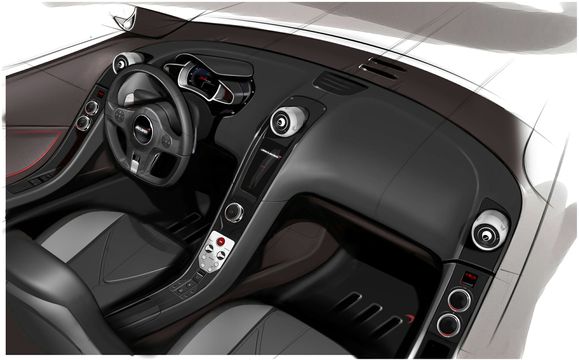Packaging was fundamental to the McLaren MP4-12C design challenge. Externally, the car had to be compact, yet internally it had to offer an unparalleled driver and passenger environment where comfort and driving enjoyment at all levels were not compromised.
“With the interior, we have created a real step forward in the packaging of a sports car. Moving the driver and passenger closer together improves driving control and moving the pedals improves the problem of wheel well intrusion. We also repackaged many of the major components that normally sit under the dashboard to allow for more space and a unique form. Packaging is one of the 12C’s really strong points,” said Frank Stephenson.
But the creativity of the interior design itself aimed to set new standards. The whole focus is on making the 12C cockpit a uniquely comfortable and functional space. The design offers a symmetry that wraps around the occupants and makes them feel not only physically, but also emotionally comfortable.
The interior is extremely space efficient and is designed to accommodate 2 adults in comfort. This has been partly achieved by the 7 inch touch screen telematics system oriented in ‘portrait’ mode. This is a first for the automotive industry and is more intuitive than ‘landscape’ orientation – we read down a page and our mobile telephones and other personal information devices are configured this way.
This is one of the many reasons the 12C design is able to buck the trend towards ever wider sporting cars. The innovative information centre provides all normal telematics functions such as audio, navigation and telephony, while providing some new features never before seen in a car. Meridian, the renowned producer of state-of-the-art sound systems, is developing its first ever in-car system for the 12C.
The low cowl gives a full six degrees downward vision from eye height and, importantly, allows the driver a clear view of the front of the car. The view of the top of the front wings, with the highest point positioned directly above the centre of the wheel, also facilitates perfect placement of the 12C in a corner. Rear vision is excellent too and an internal buttress with a rear three-quarter glass provides a clear rearward view.
The steering wheel is probably the most important sensory item for any driver. Apart from the feel and feedback from the front wheels, the actual grip and design of the wheel itself is paramount. The steering wheel is ‘clean’ – there are no buttons to distract the driver. It also needs to be small and very tactile.
McLaren designers and engineers found the solution to the steering wheel design challenge under their own roof. Having employed an advanced and compact airbag, the steering wheel design was then inspired by McLaren’s racing expertise.
The steering wheel grip of the 12C is as technically precise as a McLaren racing driver’s wheel. This is because past Formula 1 championship-winning drivers’ grips were modelled and scanned and the most effective feel and thickness of their wheels was replicated for a high performance road car. Such attention to detail is to be found throughout the McLaren 12C’s interior and the car does not suffer an over abundance of switches, knobs and dials.
The layout and ergonomics of the interior are aided by the 12C’s packaging. The driver and passenger sit closer together, giving the driver a better feeling of control for placing the car on the road accurately as well as leaving more room between the driver and the door panel. This allows not only more space for arm movements during hard driving, but also provides space for an additional ‘door console’.
Like the McLaren F1, the driver has controls on both sides, which allows for a rational positioning of switches:
- Climate controls on each door console
- Telematics on the upper centre console
- Active Dynamics Panel on the middle centre console
- Transmission and minor controls on the tunnel console
- Trip computer and cruise controls on steering column
As such, all groups of controls have their own place and are accessible within a hand’s distance from the steering wheel. The instrument cluster has a large central tachometer and digital speed readout. Behind the steering wheel (and moving with it) is a Formula 1-inspired rocker for changing gears. It has been engineered to deliver a Formula 1 haptic. The science of haptics has been applied to all the controls in order to generate a consistent and high quality feel. All the controls are bespoke, designed exclusively by McLaren, and not a single one has come from the parts bin of another manufacturer.
The Active Dynamics Panel provides two rotary switches and four push buttons:
- ‘Start/Stop’
- ‘Active’ activates all the dynamic controls.
- ‘Winter’ sets powertrain, suspension and electronic aids to maximum driver support.
- ‘Launch’ initiates the launch control system.
The two rotary switches control ‘powertrain’ and ‘handling’, each having three position settings for normal, sport and high performance driving modes.
- ‘Powertrain’ changes throttle response, gearbox strategy, shift times and impulse (how much one can feel the gearchange). The coaxial ‘Manual’ button controls use of manual gearbox functions.
- ‘Handling’ changes stability control, steering weight, suspension firmness and roll stiffness. The coaxial ‘Aero’ button allows the driver to deploy the airbrake for increased downforce.
The supportive, light weight seat is comfortable and electrically-adjustable for height. There is plenty of stowage space in the car with a shelf behind the seats big enough for small bags and a ‘floating’ centre console that leaves space beneath for a large storage container.
The interior’s simplicity belies a world-class level of comfort and safety features that will include a full quota of airbags, fully automatic dual zone climate control, sophisticated telematics and audio systems, parking sensors, trip computer, cruise control and electric memory seats.




